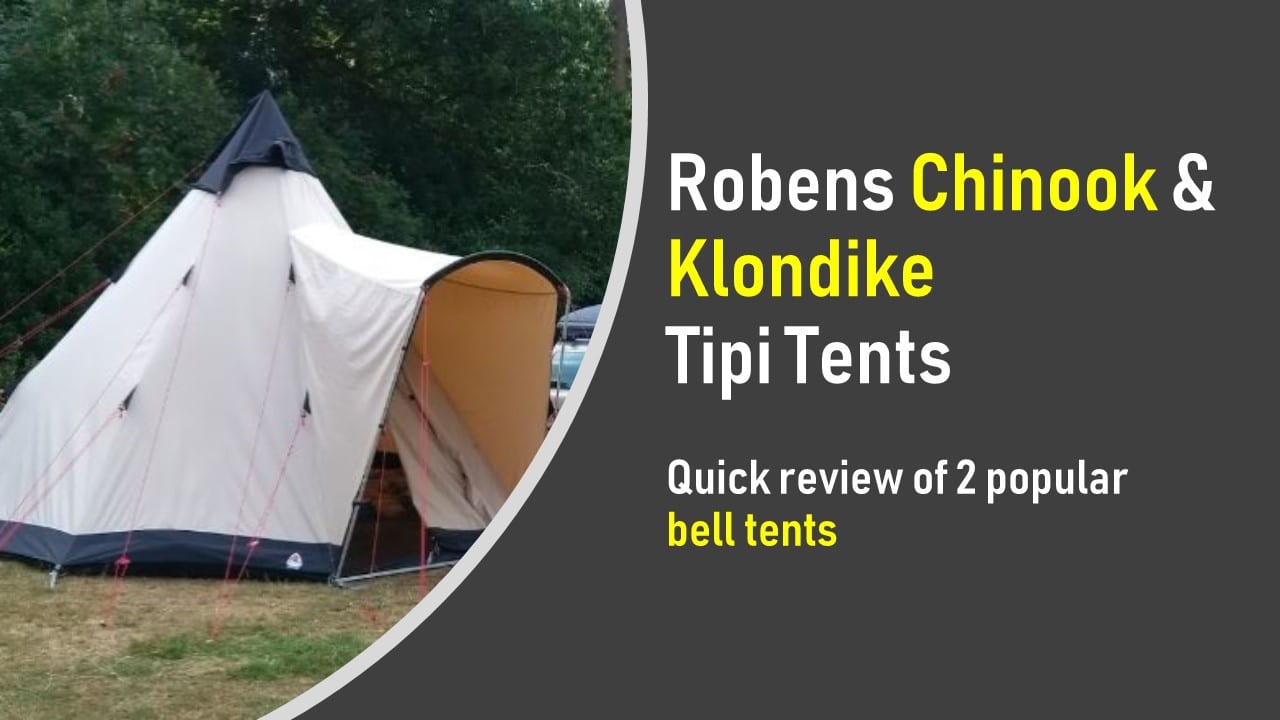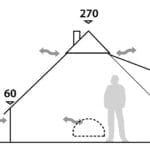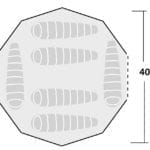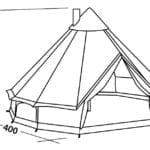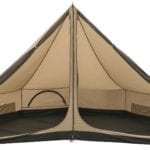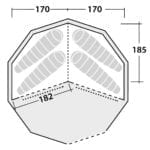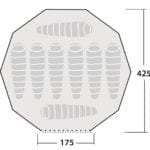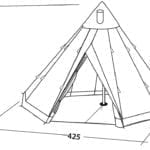There has been an increasing popularity of tipi/tepee tents and bell tents in the past few years. No wonder, the traditional design of the tipi tents has not worn over the centuries, if anything, the ‘retro’, ‘hip’ shape is more popular than ever.
Excellent build and material quality, large internal space are the features that make tipi tents appealing for families. A mid-size polycotton tipi tent for 6-8 persons is not heavier than 20kgs, they are easy to assemble, and the costs are in par with any large family tent.
Their price varies from as low as £400 (small ones) to £1000 and above (large, cotton bell tents).
In this article I wanted to show you two great tipi tents examples by Robens, the 6-men Klondike and the 8-men Chinook. At the end I also show you a trick to get the Chinook for the price of the Klondike (well, close, but really cheap…).
But a bit of ranting first…What frustrates me the most, that even manufacturers confuse tipi tents with bell tents.
Tipi Tent or Bell Tent?
There is a great post on Yurts v. Tipis v. Bell tents on this blog here (link here, opens in a new tab), if you have the time is worth the read.
In a nutshell, tipis (teepees) were originally formed by covering wooden poles with animal skins by the indigenous people in Canada and North America. Tipis were designed to be easy to transport as their nomadic owners wandered from one camp to another.
Bell tents on the other hand are a far more recent development. The predecessor of today’s bell tents was originally designed by a military officer in 1856. They were called ‘Sibley tents’ after their inventor. Sibley’s design was an adaptation of a tipi to be used in war. Compared to the tipis, these were quicker to assemble and dismantle thanks to the one metal pole used to create the structure, rather than using many wooden poles.
It brings us to the question, what do you call a tent that has a pole in the middle?
Well, apparently, manufacturers call them Tipi Tents…
It seems that the name ‘bell tent’ is reserved for the high-end models with canvas cover (heard about glamping…?) while the ‘cheaper’ bell tents or hybrid structures with polycotton cover remained ‘tipi tents’.
(Don’t know what’s the difference between polycotton and cotton canvas? Read my FAQ here!)
Robens Klondike
Who is the Robens Klondike for?
The Klondike is a spacious 6-person tent, with plenty of space for everyone despite the moderate size floor area. You can easily fit two double beds inside if you fancy camping with style, or you can upgrade with the Inner Tent. The 2-bedroom Inner Tent turns the Klondike into a 4-person tent. It is easy to carry, easy to pitch, which makes it a great partner for families or friends camping together.
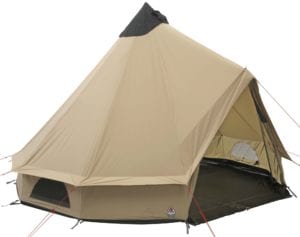
Robens Klondike – Classic Bell Tent Shape
Pitching
The Robens Klondike is a 6-person Tipi Tent with one centrally positioned lightweight pole. I promise this is the last time I mention this whole tipi tent vs. bell tent argument (but grr….), I just wanted to emphasise that the Klondike is a classic bell tent, despite what name Robens have given to it.
Having only one pole in the middle, and an aluminium A-frame at the entrance, pitching is a real piece of cake.
Size
The Klondike has 60cm tall side walls that help maximise the inner space. The maximum height at the middle is 270cm, which obviously drops as you go closer to the sides.
The front (and only) entrance is 175cm tall, and this is the highest point, so you probably will need to bend a bit. The door is held by an A-frame, that is kept in position by a guy-line attached to it at the top. This guy-line cuts your entry path right in the middle, so be careful going in an out the tent, especially at night…
Having said that, all guy-lines have a bright red colour.
- Klondike drawing
- Klondike floorplan
- Klondike drawing 2
The 13.5 sqm sleeping area can accommodate up to 6 persons.
If you are in it for glamping, the King size bed won’t fit in because of the central pole: you have approximately 2 metres to the wall sin each direction; but double beds should shift in easily (turned sideways)
If I haven’t said yet, the Klondike is VERY comfortable for 6 persons, every camper can enjoy up to 1 metre of their own sleeping area. That is far more than most – more expensive – regular family tents allocate for one person (typical values are around 65-70cm). In fact, I bet you that 8 people could sleep in it if really needed – if anyone tries it, photos or it did not happen…
Klondike Inner Tent
If you do not fancy the 6-person sleeping area, you can improve the Klondike with the Klondike Inner Tent. This turns the common sleeping area into two, 2-person bedrooms; and creates a small living room between the bedrooms and the entrance.
I think it is a clever add-on, however a bit pricy on top of the original price of the Klondike.
- Klondike inner tent
- Klondike inner tent floorplan
Materials, weather resistance
A HydroTex polycotton flysheet protects you from the elements, it is made of 35% Cotton and 65% polyester. It is lightweight and durable, combining the best features of a polyester tent and a cotton canvas tent.
Thanks to the canvas weaves, polycotton has much better thermal properties than polyester: keeps cooler in summer, stays warmer in cold weather. Thanks to the polyester part, polycotton is less likely to mildew than canvas tents, they dry quicker, and they are much lighter too.
The zipped in groundsheet is 210T Oxford polyester with 10,000mm HH – this is more than enough to rest assured that water won’t seep through from the ground.
Thanks to Signey’s clever design, the structure can withstand high winds too: the Klondike can resist winds up to 128kmh / 80mph. However, that’s far from the ideal camping / glamping weather…
Ventillation
There are three windows on the side walls, that’s about enough of low level vents. The front door is partially meshed, so you can let some air in and keep the insects out.
There is also a clever pulley system at about head height that opens the top vent. You pull the rope, and it lifts the cap off the top…nice…
Robens Chinook
The Chinook is very similar to the Klondike, albeit slightly bigger. The Chinook resembles classic tipi tents even more as there are no vertical sidewall, however, the middle pole structure is like other bell tents as the Klondike.
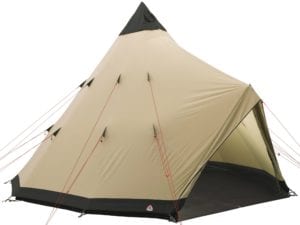
Robens Chinook – Looks like a tipi tent…
What is the difference to the Klondike?
The footprint is slightly bigger, 14.3sqm, but not that bigger to chuck two more people in it at the same comfort level they could have enjoyed in the Klondike. It is big enough to sleep 8, everyone can enjoy 75cm sleeping space or more. This is still plenty…
You can squeeze in king size beds, but only sideways. Now it shows how handy it would be to have 60cm tall sidewalls like the Klondike. Despite being taller (300cm), the Chinooks tipi style design limits the useful floorspace…
As for the materials used, everything is the same as on the Klondike. Same flysheet, same zipped in ground sheet.
As the zippers can open, the groundsheet can be rolled up at the entrance, so you can leave your muddy boots ‘outside’ the living room.
There is also an A-frame, creating a sheltered entrance over the part-mesh front doors.
- Chinook floorplan
- Chinook schematic drawing
Who is the Chinook for?
The Chinook, just like the Klondike is 3 tents in one.
- Great for campers, ramblers, friends camping together. It only weighs 20kg, my backpack was heavier when I walked across Tuscany in 2009.
- Great for families. There’s plenty of space, you can have a bespoke stove inside thanks to the stovepipe port on the top. With the optional inner tent for the Chinook, it is highly customisable
- Great for glamping. A king-size bed fits in easily, and there is still plenty of room left. Thanks to the polycotton flysheet, the Chinook is not too cold, not too hot, perfect for enjoying a nice rose spritzer.
Chinook, For £200 Less
Not that I have anything against the Klondike, and the Chinook is far more expensive anyways.
Try this:
Check the price of the Chinook at Leisure Outlet, where it is the cheapest right now (Robens Chinook at Leisure Outlet here) (or just google it and find the best price).
Go to GoOutdoors, find the Chinook (here). Look for the little light box on the right-hand side that says ‘Found a lower price online? We beat it by 10%’.
Look for this
Click on it and read it carefully, how you can redeem your price match guarantee.
Tada…you just bought the Chinook for 10% less than the cheapest, £200 off the online price.
Of course it works with anything that GoOutdoors stock.
The Klondike is currently the cheapest at GoOutdoors anyways (link here), so if you prefer it for £450 versus the Chinook for £560 (with the price match guarantee) that’s absolutely fine.
